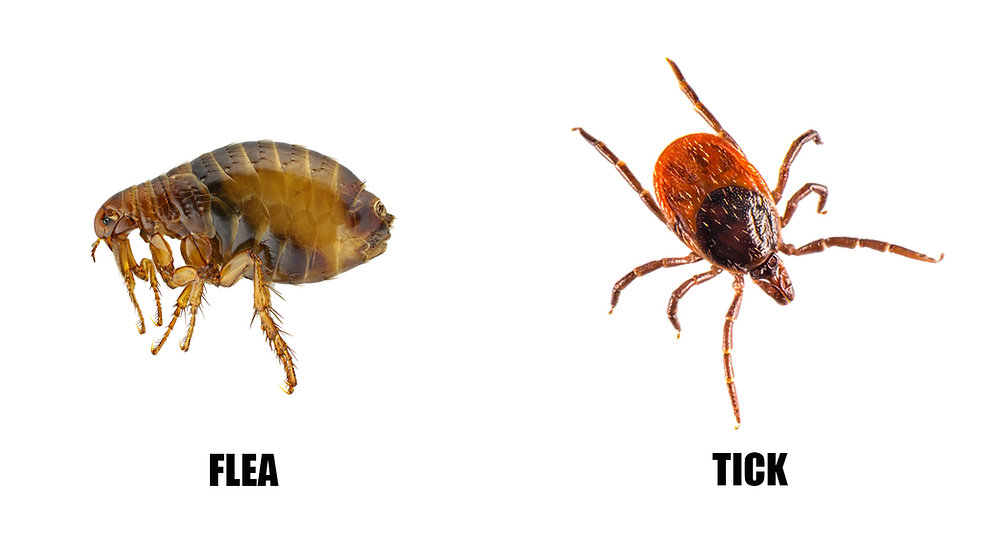If you’re a pet owner, you’ve probably heard about both ticks and fleas as common pests to watch out for. While both are parasitic insects that feed on the blood of animals (and sometimes humans), there are key differences between the two—and knowing what sets them apart is essential for protecting your pets’ health.
In this post, we’ll explore how ticks and fleas differ in appearance, behavior, risks, and prevention. Understanding these differences will help you make informed decisions about pest control and your pet’s well-being.
Appearance and Movement
Fleas are tiny, wingless insects—usually brown or reddish-brown—and they’re known for their incredible jumping ability. Adult fleas are about 1–3 mm long and are typically found crawling or jumping through your pet’s fur. Their flat bodies are built for moving quickly between hairs and evading detection.
Ticks, on the other hand, are arachnids—more closely related to spiders than to insects. They have eight legs, and adults range in size from a sesame seed to a pencil eraser, depending on their life stage and whether they’ve fed recently. Unlike fleas, ticks do not jump or fly. They crawl slowly and attach themselves to a host by waiting in grass or brush (a behavior called “questing”) and latching on when an animal brushes past.
Life Cycle and Environment
Fleas thrive in warm, humid environments and reproduce rapidly. A single female flea can lay up to 50 eggs a day. These eggs fall off your pet and into your home, where they can develop into larvae, then pupae, and finally adult fleas. This cycle can repeat quickly, making infestations hard to eliminate without prompt action.
Ticks have a slower life cycle, often spanning several months to years. They have four life stages: egg, larva, nymph, and adult. Each stage requires a blood meal to progress. Ticks are typically found outdoors, in wooded or grassy areas, where they wait for a host. While they don’t multiply in the home like fleas do, they can be more dangerous due to the diseases they transmit.
Health Risks to Pets (and Humans)
Here’s where the distinction between ticks and fleas becomes particularly important: the health risks they pose are very different.
Fleas can cause:
- Intense itching and allergic reactions (flea allergy dermatitis)
- Anemia from blood loss, especially in small pets or puppies
- Tapeworms, which fleas can carry and transmit if ingested
Ticks, meanwhile, are known for carrying more serious diseases, including:
- Lyme disease
- Rocky Mountain spotted fever
- Ehrlichiosis
- Anaplasmosis
These illnesses can have long-term consequences for both pets and humans. Ticks attach firmly and feed slowly—often going unnoticed for days—which gives them ample time to transmit bacteria or viruses.
How to Tell Which One Your Pet Has
If your pet is scratching or biting their skin excessively, you might suspect fleas or ticks. Here are some signs to help you tell the difference:
- Fleas leave behind “flea dirt”—tiny black specks that look like pepper and turn red when wet (because they’re digested blood). You may also see them jumping or crawling.
- Ticks are easier to spot once they’ve latched on. They appear as a small bump, often around the ears, neck, or between toes. They grow in size as they feed and must be removed carefully to avoid leaving parts embedded in your pet’s skin.
Prevention and Control
Protecting your pet from both ticks and fleas involves a combination of regular treatment, environmental control, and awareness.
Preventative Medications: Many vet-approved products are designed to protect against both ticks and fleas. These include oral medications, topical treatments, and collars. Always choose a product appropriate for your pet’s species, age, and weight.
Home and Yard Maintenance:
- Regularly wash pet bedding and vacuum carpets.
- Mow lawns and trim shrubs to reduce tick habitats.
- Use flea and tick control products for your home and yard, especially in high-risk seasons.
Routine Checks: After spending time outdoors, especially in wooded or grassy areas, check your pet (and yourself!) for ticks. The quicker you find and remove them, the lower the risk of disease transmission.
Why It Matters
Understanding the difference between ticks and fleas isn’t just about avoiding discomfort—it’s about preventing serious health issues. Fleas might be more annoying on a day-to-day basis, but ticks pose a greater threat in terms of disease. Knowing how to spot each, prevent them, and act quickly can make all the difference for your pet’s health and happiness.
If you’re unsure whether you’re dealing with fleas, ticks, or something else, it’s best to consult your veterinarian or a pest control professional. Prevention is always easier—and safer—than dealing with a full-blown infestation. We recommend tick control newtown.


